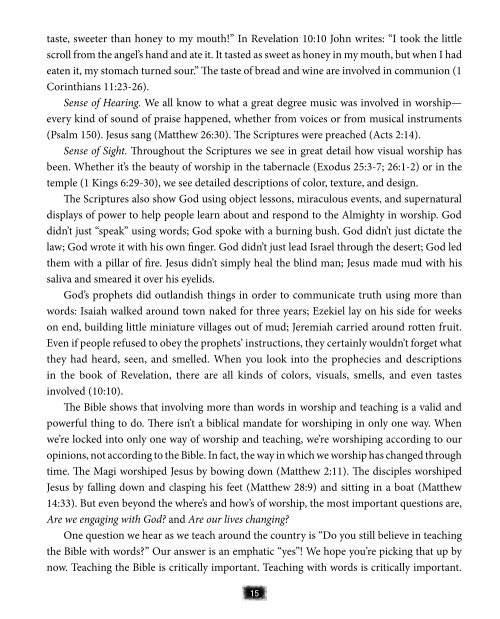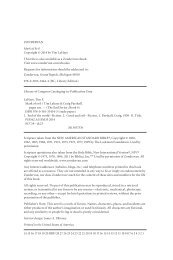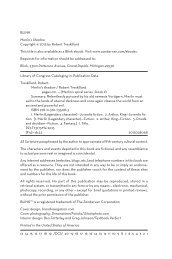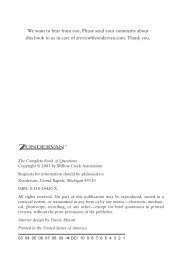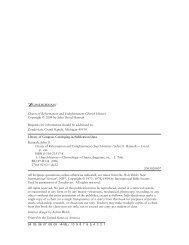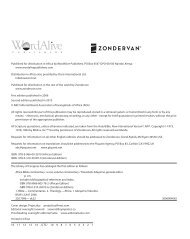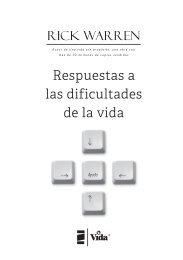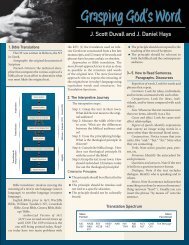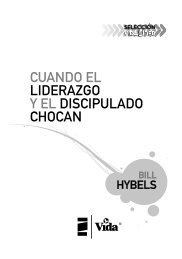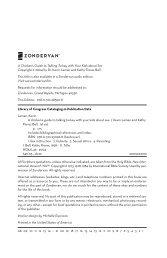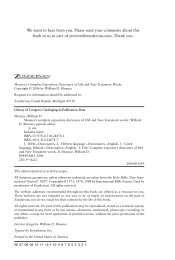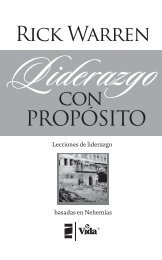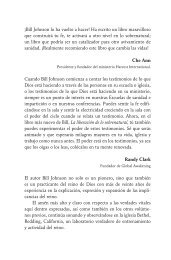Sacred Space: A Hands-On Guide to Creating Multisensory Worship ...
Sacred Space: A Hands-On Guide to Creating Multisensory Worship ...
Sacred Space: A Hands-On Guide to Creating Multisensory Worship ...
- No tags were found...
Create successful ePaper yourself
Turn your PDF publications into a flip-book with our unique Google optimized e-Paper software.
taste, sweeter than honey <strong>to</strong> my mouth!” In Revelation 10:10 John writes: “I <strong>to</strong>ok the littlescroll from the angel’s hand and ate it. It tasted as sweet as honey in my mouth, but when I hadeaten it, my s<strong>to</strong>mach turned sour.” The taste of bread and wine are involved in communion (1Corinthians 11:23-26).Sense of Hearing. We all know <strong>to</strong> what a great degree music was involved in worship—every kind of sound of praise happened, whether from voices or from musical instruments(Psalm 150). Jesus sang (Matthew 26:30). The Scriptures were preached (Acts 2:14).Sense of Sight. Throughout the Scriptures we see in great detail how visual worship hasbeen. Whether it’s the beauty of worship in the tabernacle (Exodus 25:3-7; 26:1-2) or in thetemple (1 Kings 6:29-30), we see detailed descriptions of color, texture, and design.The Scriptures also show God using object lessons, miraculous events, and supernaturaldisplays of power <strong>to</strong> help people learn about and respond <strong>to</strong> the Almighty in worship. Goddidn’t just “speak” using words; God spoke with a burning bush. God didn’t just dictate thelaw; God wrote it with his own finger. God didn’t just lead Israel through the desert; God ledthem with a pillar of fire. Jesus didn’t simply heal the blind man; Jesus made mud with hissaliva and smeared it over his eyelids.God’s prophets did outlandish things in order <strong>to</strong> communicate truth using more thanwords: Isaiah walked around <strong>to</strong>wn naked for three years; Ezekiel lay on his side for weekson end, building little miniature villages out of mud; Jeremiah carried around rotten fruit.Even if people refused <strong>to</strong> obey the prophets’ instructions, they certainly wouldn’t forget whatthey had heard, seen, and smelled. When you look in<strong>to</strong> the prophecies and descriptionsin the book of Revelation, there are all kinds of colors, visuals, smells, and even tastesinvolved (10:10).The Bible shows that involving more than words in worship and teaching is a valid andpowerful thing <strong>to</strong> do. There isn’t a biblical mandate for worshiping in only one way. Whenwe’re locked in<strong>to</strong> only one way of worship and teaching, we’re worshiping according <strong>to</strong> ouropinions, not according <strong>to</strong> the Bible. In fact, the way in which we worship has changed throughtime. The Magi worshiped Jesus by bowing down (Matthew 2:11). The disciples worshipedJesus by falling down and clasping his feet (Matthew 28:9) and sitting in a boat (Matthew14:33). But even beyond the where’s and how’s of worship, the most important questions are,Are we engaging with God? and Are our lives changing?<strong>On</strong>e question we hear as we teach around the country is “Do you still believe in teachingthe Bible with words?” Our answer is an emphatic “yes”! We hope you’re picking that up bynow. Teaching the Bible is critically important. Teaching with words is critically important.15


